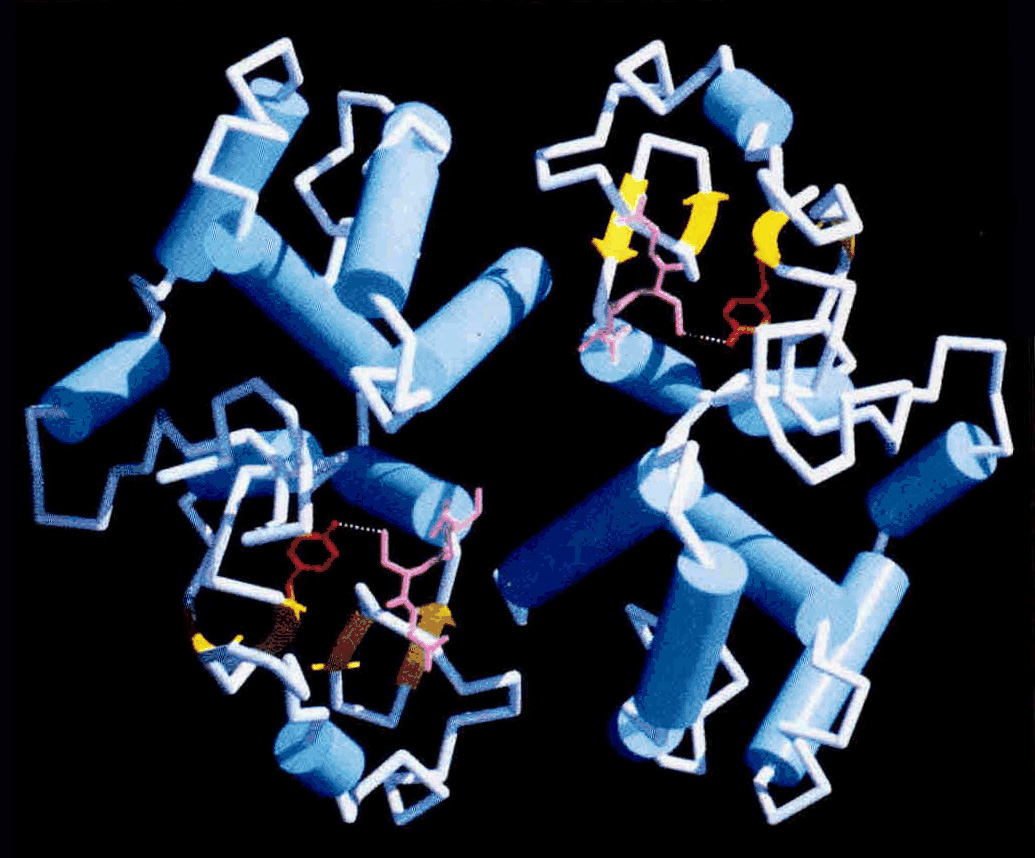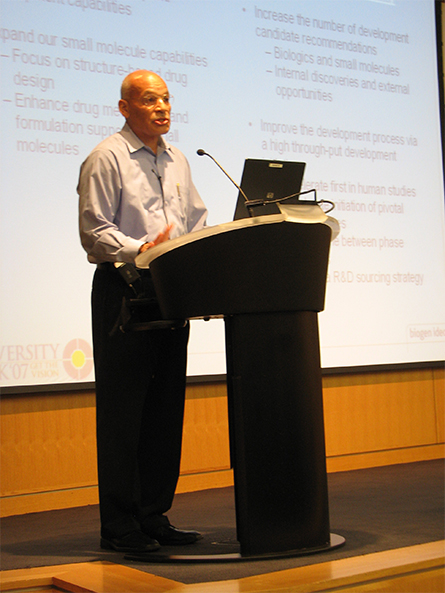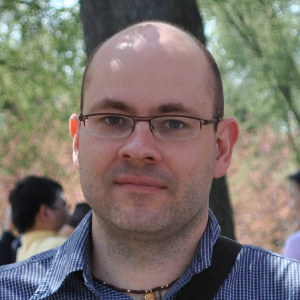Cecil Pickett: Advancing drug metabolism and discovery
This past Oct. 5, Cecil Pickett found himself celebrating a doubly special occasion. Not only did the date mark his 64th birthday, but it also marked his retirement from Biogen Idec Inc., where he served as president of research and development since 2006. The event brought to a close a sterling 32-year career in the pharmaceutical sector, which included stops at Merck & Co. Inc. and the Schering-Plough Corp. before his appointment at Biogen Idec.
Over that period of time, Pickett and his research teams have been responsible for important breakthroughs, like the development of widely used medicines, such as Zetia, Noxafil and Singulair, as well as the more basic studies elucidating the function and regulation of drug-metabolizing enzymes like glutathione-S-transferases. Together, these achievements show that pursuing a career in the pharmaceutical or biotech industry can provide the best of both worlds — being able to carry out projects that can impact human health directly while at the same time conducting valuable fundamental research.
“Overall, I felt that life as an industry researcher was really not much different than that of an academic one,” Pickett says. “You oversee a laboratory, hire postdocs and technicians, sit on committees and publish articles about your work. And, in the end, I think that the quality of basic research that comes out of industry is on par with that of major academic institutions.”
In Pickett’s case, at least, many will be quick to agree. “I’ve spent a long career in industry and been involved in the development of many drugs,” says American Society for Biochemistry and Molecular Biology member Al Alberts, who helped bring Pickett into the Merck family many years ago. “But I think it’s safe to say Cecil was probably my biggest contribution during my time at Merck.”
A hard day’s night
Looking back at Pickett’s extraordinary career, a phrase that’s often used to describe the modest scientist would be “strong work ethic” and that trait was present long before Pickett took on his first industry position at Merck & Co. in 1978. As one of nine children, Pickett, who grew up in the small Illinois town of Canton, began working almost as soon as he could walk to help support his family, including jobs delivering newspapers and mowing lawns.
In school, he became interested in math and science early on, particularly chemistry and biology, and decided to pursue that path in college. And after growing up in the rural Midwest, he was eager for some adventure and headed off to California, where he attended the University of California, Berkeley, and later transferred to nearby California State University, Hayward, which is now known as California State University, East Bay. He continued his hardworking ways and took on full-time jobs to support his education — first in a university chemistry lab and later at Cutter Laboratories.
Pickett notes that his long list of duties made his time in college difficult. “After I finished all of my classes for the day, I went straight to the lab to work on the second shift, or sometimes I even worked on the graveyard shift, so I really didn’t have time to enjoy my college experience,” he says. However, in 1971, all of the work paid off as Pickett received his bachelor’s degree, becoming the first member of his family to graduate college.

Although his undergraduate days were a bit trying, Pickett’s next destination, graduate school at the University of California, Los Angeles, was the exact opposite: total fun. “I couldn’t believe they actually paid me to go to school,” he says. “I could now spend all of my time actually focusing on my research or the classes I was taking.”
That research would entail looking at the heterogeneity of mitochondria and their interaction with the endoplasmic reticulum, under the guidance of Joseph Cascarano. Pickett notes that Cascarano was demanding as a mentor and expected a lot of his students, but Pickett was quite comfortable with demanding schedules. After completing his Ph.D. in 1976, Pickett even spent two more years as a postdoctoral fellow at UCLA, working with Cascarano and Verne Schumaker in the chemistry department.
Into the breach of industry
As he was deliberating his next career move, Pickett became very interested in a particular Journal of Biological Chemistry paper he had come across that discussed the conversion of preproalbumin to proalbumin. The corresponding authors on that paper were Al W. Alberts and P. Roy Vagelos, who worked at the Merck, Sharp & Dohme Research Laboratories.
“I remember seeing that affiliation and not even realizing that it represented a pharmaceutical company,” Pickett says. “In graduate school, I wasn’t really educated about the potential of doing research in industry, so the name didn’t mean that much to me.”
Still, Pickett decided to write a letter to Vagelos and ask if he could join his laboratory; he was startled when he later found out exactly what Merck was but also was pleasantly surprised when he received an offer to join the company. “Cascarano was very influential in my decision to accept the offer,” Pickett says. “He had done an internship with a pharmaceutical company, so he was familiar with the culture of industry. And, although he hoped I would consider staying in academia, he told me that Merck would be a good place to work, because they had a strong history of supporting science.”
Pickett soon would experience this supportive culture firsthand. At one of the first meetings he had with Alberts and Vagelos, the recently appointed head of Merck Research Laboratories, he was told to respect the company’s long-term goals and interests but that he should not be afraid to try to establish his own career and pursue his own interests.
“I found that very enlightening,” Pickett says. “But I think Vagelos was ahead of the curve in that he understood that individuals given the freedom to be creative often come up with the initial discovery that eventually leads to a new drug, and he made a concerted effort to seek out talented people in academia to fill out positions in Merck. I feel extremely fortunate that I was chosen near the forefront of that effort.”
Pickett was also fortunate in that scientist Anthony Y. H. Lu had just joined Merck.

“During my studies of the association between mitochondria and endoplasmic reticulum, I had become interested in cytochrome P-450, as its biosynthesis was connected with the formation of endoplasmic reticulum-mitochondria complexes,” Pickett says. “And Lu was a noted expert in P-450 biochemistry.” Together, they formed a collaboration to try to quantify the activity of specific cytochrome P-450 enzymes after exposure to xenobiotics. This was a vital enterprise, as P-450 enzymes are the major elements involved in drug metabolism, and understanding P-450 interactions is critical in determining proper drug dosage and identifying any risks of multidrug regimens.
“This has been one area that often gets overlooked in discussing the advances made by the pharmaceutical industry,” Pickett says. “When I first started in industry, the role of cytochrome P-450 enzymes was largely unknown. Today, however, for every drug we develop, we know exactly which P-450 enzyme metabolizes it.”
Climbing the ladder
Over the next three decades, Pickett remained embedded in industry, although the names and places changed as he progressed upward. After his initial assignment serving with Alberts on the development team working on the first generation HMG-CoA reductase inhibitors (statins), Pickett soon rose to the position of director of the department of molecular pharmacology and biochemistry. In 1988, he moved to Montreal to become the head of research at the Merck Frosst Centre for Therapeutic Research, where, among other duties, he recruited bright scientific minds — looking for the next Cecil Pickett, as it were. It was during his tenure that Merck Frosst researchers discovered the asthma drug Singulair. (Homage to the site of discovery can be found in the drug’s scientific name, Montelukast).
“It was becoming obvious to Merck that Cecil could lead any drug research group,” says Vagelos about his longtime colleague, “and unfortunately for Merck this was becoming apparent to others as well.”
In 1993, Pickett left Merck to become executive vice president of discovery research at the Schering-Plough Research Institute in Kenilworth, N.J., where he oversaw the planning for the company’s drug-discovery program. “After 15 years at Merck, during which time I had seen Vagelos really transform the company, I thought it would be a great challenge to help build up another organization.”
Pickett experienced great success over the next several years, which saw the development of drugs like the cholesterol absorption inhibitor Zetia and the antifungal Noxafil, and he also expanded the breadth of the drug-discovery program to include targeting central nervous system disorders. Such contributions would earn him another promotion in 2002, this time to president of the Schering-Plough Research Institute, putting him in charge of all aspects of research and development.
Despite ever-increasing administrative duties with each passing promotion, Pickett continued to oversee his own laboratory and independent research into drug metabolism. After completing his work with cytochrome P-450, he began studying glutathione-S-transferases (GSTs), another important family of enzymes involved in drug modification and metabolism. Pickett’s lab was one of the first to clone the cDNA for GST proteins, characterize their genes and examine the regulation of their expression in response to xenobiotics and oxidative stress. More recently, he also has taken a closer look at Nrf2, a transcription factor that has emerged as the master regulator of the antioxidant response.
“His dedication to research was one of the things I most admire about Cecil,” says colleague Fred Guengerich of Vanderbilt School of Medicine, “especially since it carried into other areas. When it came time to make a difficult decision regarding advancing a drug, he always held true to the science.”

It was only when Pickett took his latest position at Biogen Idec in Cambridge, Mass., that he finally had to shut his research down; though, in truth, he was prepared to pretty much shut everything down before taking the job.
“I was actually ready to retire from Schering-Plough back in 2007,” Pickett says, “and take up a position on Biogen Idec Inc.’s board of directors. I had no intention of working in the R&D division, but I got to talking with the CEO, and one thing led to another. And, in the end, I agreed to work on a short-term basis to do some mentoring and help organize the research pipeline before retiring for good.”
No rest for the retired
After spending more than 30 years in the industry sector, Cecil Pickett has been witness to a tremendous amount of change. Some changes were good, such as the tremendous impact advances in molecular biology and molecular genetics — like cDNA cloning — have had. “These advances pretty much spearheaded the formation of the first biotech companies,” Pickett says.
Others were not so good, such as Merck’s recent Vioxx problems. And Pickett believes that the near future will remain difficult, given the struggling economy and the negative public perception that pharmaceutical companies often face.
Life in industry
So, what is life like within the walls of a pharmaceutical research center? As Pickett noted, in many ways, academia and industry are similar in terms of running a lab and conducting research. One important difference in his view, though, is how industries divvy up their scientists. Instead of the departmental fields seen in universities, pharmaceutical researchers are grouped based on their specializations within the drug pipeline; whether it’s the discovery team that identifies potential drug targets, a process chemistry team that scales up drug production, a formulation team that formulates a drug for optimal delivery or the toxicology team that tests a drug’s effects in animals. “So, while the first stages of drug design can begin with just a handful of people, by the time it’s ready for the clinic, potentially more than 100 people have become involved.” Pickett believes that being willing to work in such a team-oriented structure is a key factor for industry success. (Although it’s also becoming more important in academia as well.) “If you think you can be independent and just concentrate within your own lab, your industry experience will not be rewarding."
“The pharmaceutical industry is somewhat constrained, because it only can be successful by continually discovering new and innovative products,” Pickett says, “and it’s true that some organizations have become so large that bureaucracy is stifling innovation. If pharma CEOs manage based on short-term earnings, they cannot succeed in an area that requires long timelines for success.”
However, he’s hopeful that pharmaceutical companies can remain relevant in today’s times.
“Large pharmaceutical companies, I think, might be well served to increase partnerships with smaller companies, where innovation is still strong,” he says. “And if they can do that, think long term and focus on recruiting and retaining bright individuals, there’s no reason they can’t continue to be one of our most premier companies. Every great drug discovery started simply — with a creative individual and a good idea.”
As for Pickett’s own rosy post-retirement future, don’t expect him to rest on his laurels. He currently holds an adjunct professorship at Rutgers University and will maintain an office there, spending time working with graduate students. This mentoring certainly won’t be a new experience, though. Throughout his career, Pickett has demonstrated a strong commitment to mentoring young scientists, particularly minority students and fellows, and using his resources to strive for diversity in the industry sector. As several of his colleagues would point out, his activities as a role model are even more impressive considering the corporate environment, which usually tasks superiors to ‘manage’ as opposed to ‘mentor.’
And, in an interesting twist, he’s even thinking of starting up his lab again, giving himself a taste of the academic life he forwent all those years ago. “It’s only been a couple of years since my last experiment,” he says. “I don’t think I’m too far out of the loop in terms of the science.”
References
Pickett, C. B., Rosenstein, N. R., and Jeter, R. L. (1981) The Physical Association between Rat Liver Mitochondria and Rough Endoplasmic Reticulum. II. Possible Role RER-MT Complexes Play in the Biosynthesis of Cytochrome P-450. Exp. Cell. Res. 132, 225–234.
Pickett, C. B., Jeter, R. L., Morin, J., and Lu, A. Y. (1981) Electroimmunochemical Quantitation of Cytochrome P-450, Cytochrome P448, and Epoxide Hydrolase in Rat Liver Microsomes. J. Biol. Chem. 256, 8815–8820.
Pickett, C. B., Telakowski-Hopkins, C. A., Ding, G. J., Argenbright, L., and Lu, A. Y. (1984) Rat Liver Glutathione S-transferases. Complete Nucleotide Sequence of a Glutathione S-transferase mRNA and the Regulation of the Ya, Yb, and Yc mRNAs by 3-Methylcholanthrene and Phenobarbital. J. Biol. Chem. 259, 5182–5188.
Rushmore, T. H., and Pickett, C. B. (1993) Glutathione S-transferases, Structure, Regulation, and Therapeutic Implications. J. Biol. Chem. 268, 11475–11478.
Nguyen, T., Huang, H. C., and Pickett, C. B. (2000) Transcriptional Regulation of the Antioxidant Response Element: Activation by Nrf2 and Repression by MafK. J. Biol. Chem. 275, 15466–15473.
Nguyen, T., Nioi, P., and Pickett, C. B. (2009) The Nrf2-antioxidant Response Element Signaling Pathway and its Activation by Oxidative Stress. J. Biol. Chem. 284, 13291–13295.
Enjoy reading ASBMB Today?
Become a member to receive the print edition four times a year and the digital edition monthly.
Learn moreGet the latest from ASBMB Today
Enter your email address, and we’ll send you a weekly email with recent articles, interviews and more.
Latest in People
People highlights or most popular articles

Meet the editor-in-chief of ASBMB’s new journal, IBMB
Benjamin Garcia will head ASBMB’s new journal, Insights in Biochemistry and Molecular Biology, which will launch in early 2026.

Exploring the link between lipids and longevity
Meng Wang will present her work on metabolism and aging at the ASBMB Annual Meeting, March 7-10, just outside of Washington, D.C.

Defining a ‘crucial gatekeeper’ of lipid metabolism
George Carman receives the Herbert Tabor Research Award at the ASBMB Annual Meeting, March 7–10, just outside of Washington, D.C.

Nuñez receives Vallee Scholar Award
He will receive $400,000 to support his research.

Mydy named Purdue assistant professor
Her lab will focus on protein structure and function, enzyme mechanisms and plant natural product biosynthesis, working to characterize and engineer plant natural products for therapeutic and agricultural applications.

In memoriam: Michael J. Chamberlin
He discovered RNA polymerase and was an ASBMB member for nearly 60 years.

